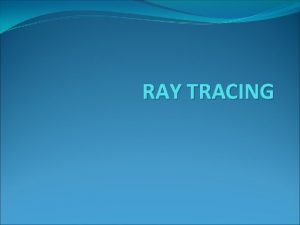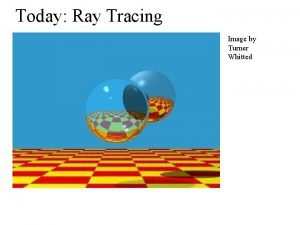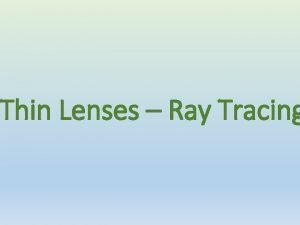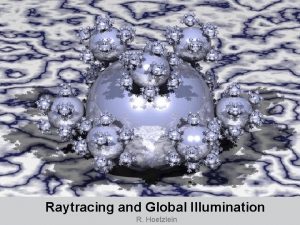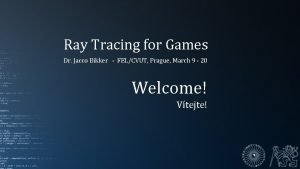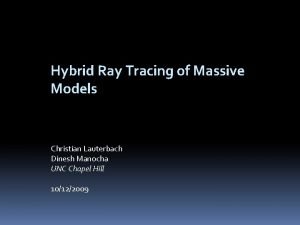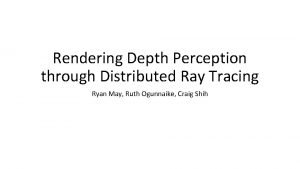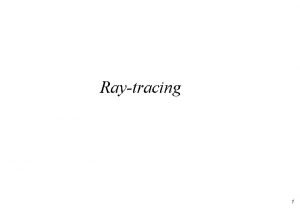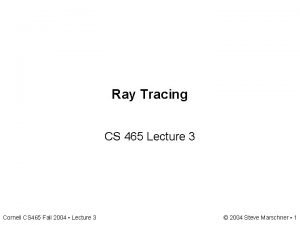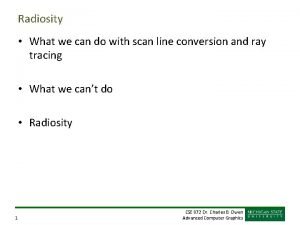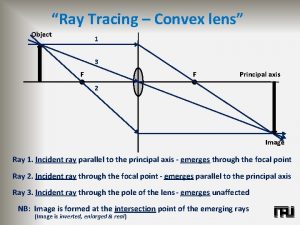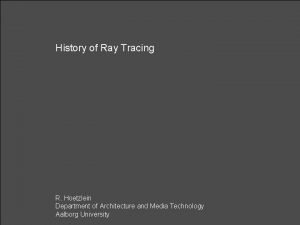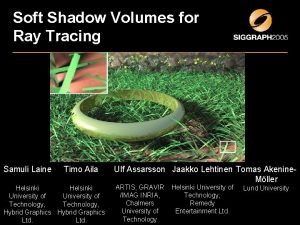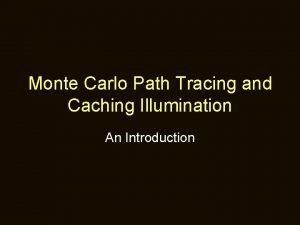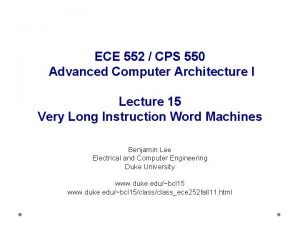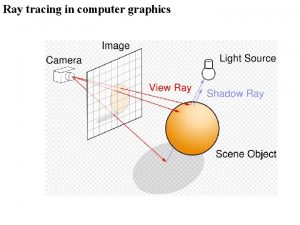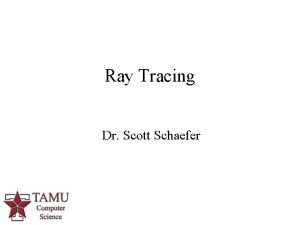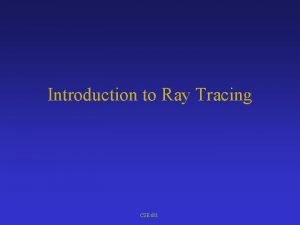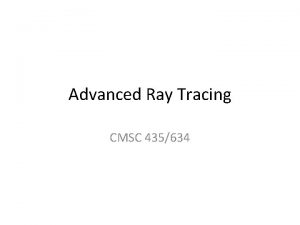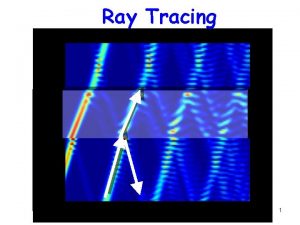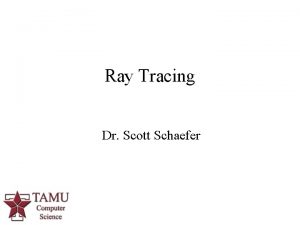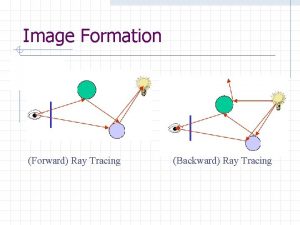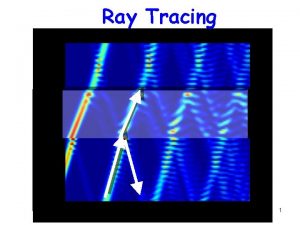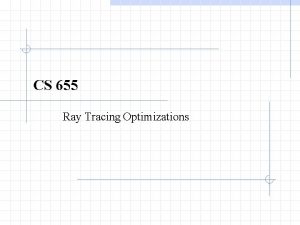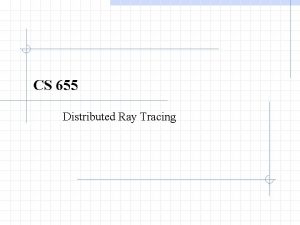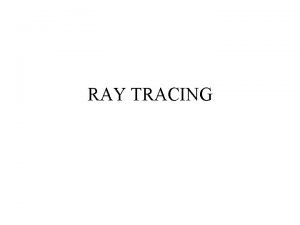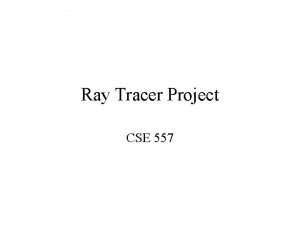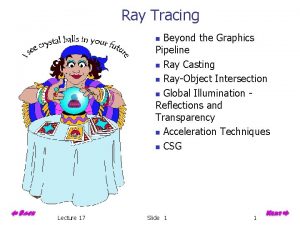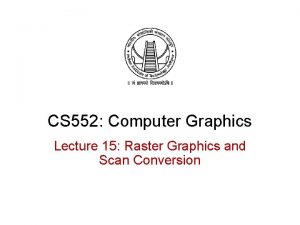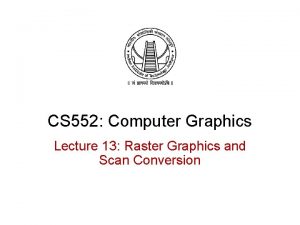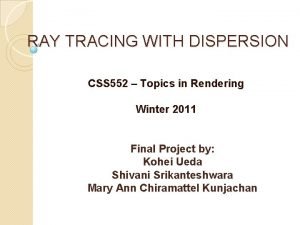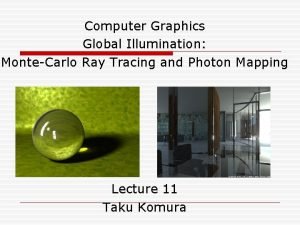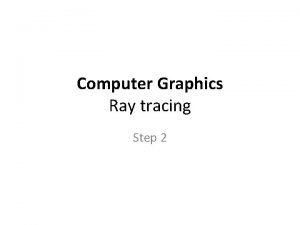CS 552 Computer Graphics Lecture 36 Ray Tracing





















- Slides: 21

CS 552: Computer Graphics Lecture 36: Ray Tracing

Recap • Visibility detection • Illumination Model

Objective • After completing this lecture, students will be able to o Apply ray tracing method for photorealistic rendering

© Gilles

The Phong Illumination algorithm cannot generate images like these

Rendering Issues • What object (part) to be visible? o Visibility Ø Clipping Ø Occlusion o Illumination Ø Reflection Ø Refraction Ø Transparency Ø Shadow

Idea A • Light_transport_from B to A: o Emmitance of B o Visibility of B from A o Distance to B from A • Also: o Reflectance of B o Light_transport_from Ci to B Ø Emmitance of C Ø Visibility of C from B Ø Distance to C from B B C 2 C 1 C 3 D 1

Assumptions • I on both sides of the equation suggests an infinitely recursive path of light transfer. o We need to make some simplifying assumptions in order to solve this equation • Local Illumination algorithms assume light only “bounces” once travelling from light source to a point in the scene and then to the eye Less realistic, usually used in real-time rendering • Global Illumination algorithms account for light transport between several points on the scene before reaching the eye (several bounces) o Thus can account for refraction, shadows, reflections etc. More expensive, usually used in off-line rendering

Local vs. Global Illumination Local Illumination depends on local object & light sources only Global Illumination at a point can depend on any other point in the scene

Ray Tracing • A photo-realistic rendering algorithm • Current ray tracing methods are attributed to Turner Whitted (Bell Labs. 1980) Whitted Illumination Model • First implementation of ray tracing in computer graphics = Appel (IBM 1968) • Recursive Raytracing, 1979 • Recorded in “An Improved Illumination Model for Shaded Display” (Bell Labs, 1980).

Ray Tracing from Eye Tracing from light source Traditional ray-tracing Starting at the light position traces many rays that never reach the eye. Thus the traditional ray-tracing method is to start at the eye and trace rays back-wards to the source.

Ray Casting Virtual Viewpoint Virtual Screen Objects Ray Multiple misses intersections: all object: objects: shade Use Pixel closest using colored one color, black (aslights, doesmaterials Open. GL)

Eye Ray and Object Intersection Cast a ray from camera position through each pixel into the scene. Calculate where this intersects with objects in the scene. Get the first intersection.

Computing Intersections • Determining the intersection of a ray with an object. • Sphere

Diffuse Term • Extend a “Shadow Feeler” (or light ray) and see if it is occluded by an object in the scene • If so the object is in shadow from this light source • Otherwise solve the phong model to calculate the contribution of this point to the colour of the pixel. • If object is diffuse stop here.

Reflection • If object is specular THEN create a ray in the direction of perfect specular reflection. • For this new ray, we will again check whether… o it intersects an object, o if so is this object in shadow o what is the contribution of this object to the colour of the pixel? • Each ray contributes to the colour of the pixel it originated from

Refraction • Similarly if the object is transmissive (not-opaque) then generate a transmitted (or refracted) ray and repeat…

The Angle of Refraction • When light passes from a material of one optical density to another it changes direction. • The amount by which the direction changes is determined by the optical densities of the two media. Air Water Air Glass Air Diamond • Optical density (and thus the amount of bending is related to a value we call the refractive index of the material.

Index of Refraction (ior) Material Index of Refraction Vacuum 1. 0000 <--lowest optical density Air Ice Water Ethyl Alcohol Plexiglas Crown Glass Light Flint Glass Dense Flint Glass Zircon Diamond Rutile Gallium phosphide 1. 0003 1. 31 1. 333 1. 36 1. 51 1. 52 1. 58 1. 66 1. 923 2. 417 2. 907 3. 50 <--highest optical density You can try these refracted index values in POVRay.

Ray Tracing Summary

Thank you Next Lecture: Ray Tracing
 Ray casting method in computer graphics
Ray casting method in computer graphics Cathode ray tube in computer graphics
Cathode ray tube in computer graphics Graphics monitor and workstation in computer graphics
Graphics monitor and workstation in computer graphics Dot matrix display ppt
Dot matrix display ppt Whitted ray tracer
Whitted ray tracer Lens ray tracing
Lens ray tracing Rasterization vs ray tracing
Rasterization vs ray tracing Ray tracing actor
Ray tracing actor Hybrid ray tracing
Hybrid ray tracing Distributed ray tracing
Distributed ray tracing Recursive ray tracing
Recursive ray tracing Albrecht dürer ray tracing
Albrecht dürer ray tracing Ray tracing vs radiosity
Ray tracing vs radiosity Raytrace technologies
Raytrace technologies Ray tracing convex lens
Ray tracing convex lens Matt phar
Matt phar Urmi ray
Urmi ray Dolphin ray tracing
Dolphin ray tracing 1/f = 1/do + 1/di
1/f = 1/do + 1/di Ray tracing soft shadows
Ray tracing soft shadows Eric veach thesis
Eric veach thesis Ece552
Ece552
